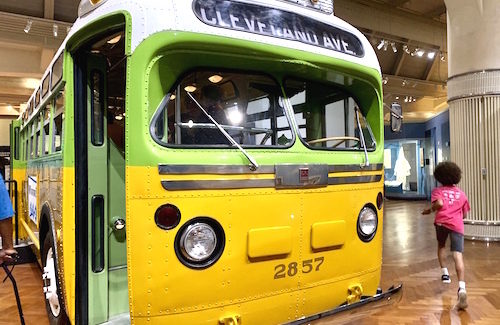Cruise Trivia: Why is This Old Bus Important?
So it’s a bus. Why should a bus be in a big museum? What makes it so special?
Do you know the answer to this cruise trivia question?
A hint – This bus rolled the streets of Montgomery, Alabama, in the 1950s. The vehicle was almost destroyed before it was saved because of its historic significance.
Don’t look at the answer below until you’ve formulated your own response. Congratulations if you know the answer.
If not, you might want to book a Victory I cruise on the Great Lakes to visit this huge museum and learn more about this bus and the story behind it.
*
*
*
(Answer)
The bus isn’t as important as the woman who was riding it.
Rosa Parks boarded this Cleveland Avenue bus on Dec. 1, 1955, in downtown Montgomery, Alabama. She was headed home after a day’s work as a seamstress at a department store.
Rosa Parks paid her fare and sat in an empty seat in the first row of back seats reserved for blacks in the “colored” section. Near the middle of the bus, her row was directly behind the 10 seats reserved for white passengers.
As the bus traveled along its regular route, all the white-only seats in the bus filled up. The bus reached the third stop in front of the Empire Theater, and several white passengers boarded.
Bus driver James F. Blake noted that two or three white passengers were standing, as the front of the bus was full. So he moved the “colored” section sign behind Parks and demanded that four black people give up their seats in the middle section so that white passengers could sit.
Three of them complied. Parks didn’t. Blake called the police and she was arrested.
In her autobiography, My Story, Rosa Parks said:
“People always say that I didn’t give up my seat because I was tired, but that isn’t true. I was not tired physically, or no more tired than I usually was at the end of a working day. I was not old, although some people have an image of me as being old then. I was 42. No, the only tired I was, was tired of giving in.”
Rosa Parks’ arrest helped initiate the civil rights movement in the United States. Leaders of the local black community organized a bus boycott that began the day Parks was convicted of violating the segregation laws.
Led by a young Rev. Dr. Martin Luther King Jr., the boycott lasted more than a year – during which Parks lost her job—and ended only when the U.S. Supreme Court ruled that bus segregation was unconstitutional.
Over the next half-century, Parks became a nationally recognized symbol of dignity and strength in the struggle to end entrenched racial segregation. She became known as “the Mother of the Civil Rights Movement.”
Rosa Parks died in Detroit on Oct. 24, 2005. She and her husband Raymond had moved to Detroit in 1957.
Even years after the 1955 incident shook the country, officials in Montgomery had no clue about the significance of that little bus.
City transit officials took it out of service in 1971 and sold it to a man who threw the seats down a ravine to make more room for his tools. When the vehicle quit running, wild animals eventually moved in and the bus was used for target practice.
Finally, someone realized its historic value and put it on the auction block. The 36-passenger bus was sold in 2001 for $492,000 to the Henry Ford Museum in Dearborn, Michigan.
The museum spent another $318,00 restoring the bus to the way it looked the day Parks boarded it and sparked the modern Civil Rights movement.
On the day I visited the Henry Ford Museum, an elderly woman sat on the bus and began softly weeping. It was tears of joy, she told me, that the bus had been preserved as an actual witness to an important chapter in American history.
Such a remarkable legacy that Henry Ford has left to the world.
Photo and cruise trivia story by Jackie Sheckler Finch















View Recent Comments